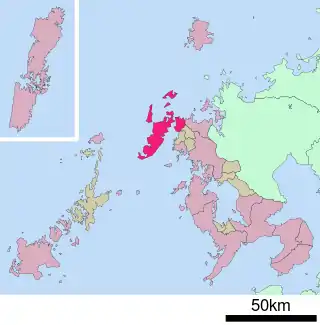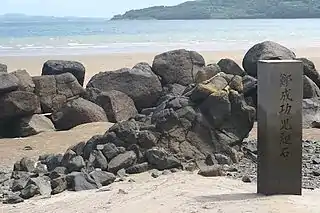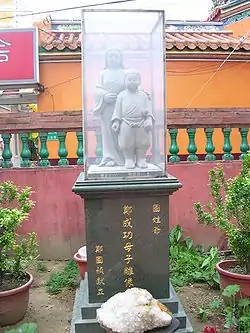平戶島
平戶島位於日本長崎縣北松浦半島西方,東西最寬約10公里,南北長約32公里,面積為163.42平方公里,是長崎縣的第4大島,日本的第20大島。行政上全島隸屬於平戶市。平戶島與北松浦半島的最狹處約相隔570公尺,於1977年起建有平戶大橋相連接[1]。
| 平戶島 | |
|---|---|
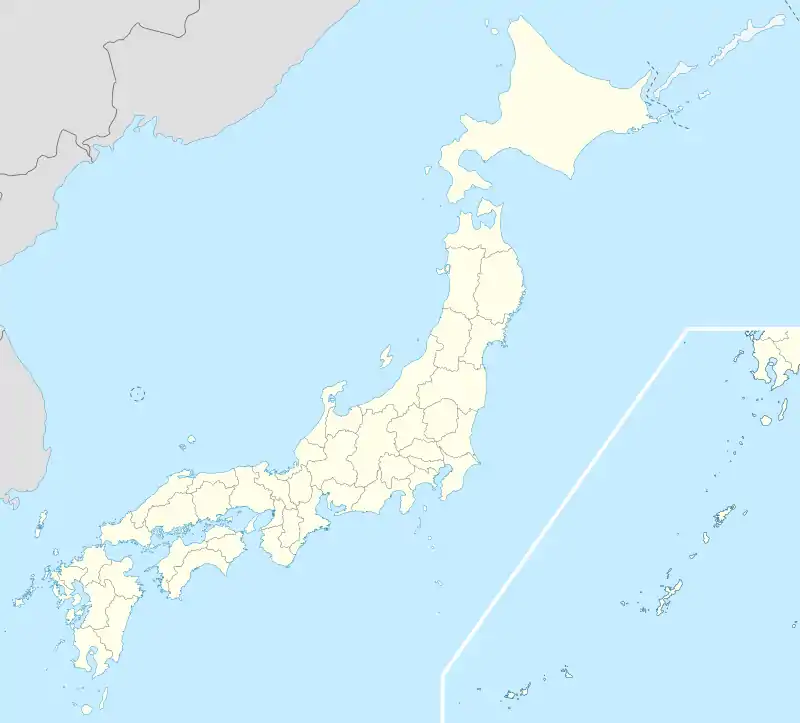 平戶島 Location in Japan | |
| 地理 | |
| 位置 | 東海 |
| 坐标 | 33°22′5″N 129°33′13″E |
| 面積 | 163.42平方(63.10平方英里) |
| 长度 | 32千米(19.9英里) |
| 宽度 | 10千米(6英里) |
| 海岸線 | 203.5千米(126.45英里) |
| 最高海拔 | 535米(1,755英尺) |
| 管轄 | |
Japan | |
| 人口统计 | |
| 人口 | 21,355 |
| 人口密度 | 131人/平方公里(339人/平方英里) |
平戶島上的平戶市是日本最早對外通商的港口城市,荷蘭人及英國人曾經於此設立工廠,然而長崎港的興起取代了平戶市[2]。在中國大陆、台灣及日本知名的鄭成功在平戶島上出生[2]。
地理
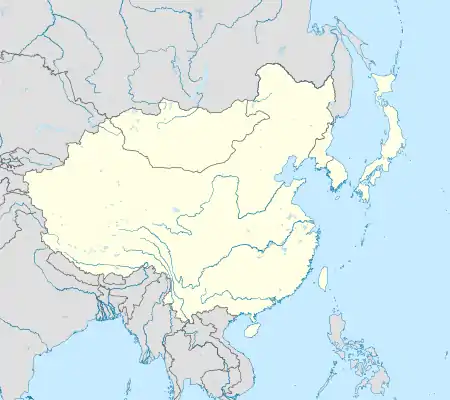
地形
The Hirado island has formed as a horst elevated from the sea in Pliocene period. Its bedrock features a mixture of the sea sedimentary rocks of Tertiary period, mixed and overlaid by the recent Igneous rock. Due to being relatively young, the island is very hilly with large fraction of area over 200 meters elevation, and flat land is limited to marginal coastal plains. The coastline is highly indented and feature a large cliffs along the entire north-west coast facing East China Sea, except for river mouths.[3]
氣候
Hirado Island is located in the humid subtropical climate zone (Köppen Cfa), with four distinct seasons. The island rarely sees snowfall during the winter. Spring in Hirado Island starts off mild, but ends up being very humid. The summer tends to be Hirado's wettest season, with the Template:Nihongo4 — the rainy season — occurring between early June (average:Jun.7) to late July (average:Jul.21). The island's weather is affected by the nearby Liman current while being shielded from the warm Kuroshio Current by the Kyushu island, resulting in wetter and colder climate than should be expected at lower 30's latitudes. The climate of Hirado Island is greatly moderated by the surrounding sea, resulting in reduced seasonal and diurnal temperature variations.
| Hirado weather station[4](1981–2010)气候平均数据 | |||||||||||||
|---|---|---|---|---|---|---|---|---|---|---|---|---|---|
| 月份 | 1月 | 2月 | 3月 | 4月 | 5月 | 6月 | 7月 | 8月 | 9月 | 10月 | 11月 | 12月 | 全年 |
| 平均高温℃(℉) | 9.3 (48.7) |
10.2 (50.4) |
13.0 (55.4) |
17.4 (63.3) |
21.2 (70.2) |
24.0 (75.2) |
27.6 (81.7) |
29.4 (84.9) |
22.2 (72) |
21.9 (71.4) |
16.9 (62.4) |
11.9 (53.4) |
19.9 (67.8) |
| 每日平均气温℃(℉) | 6.7 (44.1) |
7.3 (45.1) |
9.9 (49.8) |
14.0 (57.2) |
17.7 (63.9) |
21.0 (69.8) |
24.9 (76.8) |
26.3 (79.3) |
23.4 (74.1) |
18.9 (66) |
13.9 (57) |
9.2 (48.6) |
16.1 (61) |
| 平均低温℃(℉) | 4.1 (39.4) |
4.5 (40.1) |
6.9 (44.4) |
10.8 (51.4) |
14.8 (58.6) |
18.7 (65.7) |
23.0 (73.4) |
23.9 (75) |
21.1 (70) |
16.0 (60.8) |
11.0 (51.8) |
6.3 (43.3) |
13.4 (56.1) |
| 平均降水量㎜(英寸) | 81.5 (3.209) |
92.5 (3.642) |
156.0 (6.142) |
184.8 (7.276) |
205.4 (8.087) |
310.6 (12.228) |
362.3 (14.264) |
215.5 (8.484) |
233.4 (9.189) |
94.6 (3.724) |
104.4 (4.11) |
68.3 (2.689) |
2,109.3 (83.043) |
| 平均降雪量㎝(英寸) | 3 (1.2) |
2 (0.8) |
0 (0) |
0 (0) |
0 (0) |
0 (0) |
0 (0) |
0 (0) |
0 (0) |
0 (0) |
0 (0) |
1 (0.4) |
6 (2.4) |
| 平均相对湿度(%) | 64 | 66 | 68 | 76 | 79 | 86 | 88 | 84 | 79 | 70 | 67 | 65 | 74.3 |
| 每月平均日照时数 | 92.9 | 114.3 | 147.3 | 175.4 | 188.3 | 133.2 | 154.0 | 200.0 | 160.1 | 178.1 | 131.8 | 108.5 | 1,783.8 |
| 来源 #1:Japan Meteorological Agency[5] | |||||||||||||
| 来源 #2:NOAA (1961-1990)[6] | |||||||||||||
平戶島與東亞海洋史
.jpg.webp)


平戶島過去是日本遣唐使 前往中國及其他地區的出發據點,也一度成為倭寇的根據地[7]。
東亞海洋貿易
明朝開始,由於從事東亞海洋貿易的往來商人,平戶島從鮮少人居住轉變成船隻來往的重要據點[12]。
1628年鄭芝龍歸順明朝後,平戶島和其他的東亞海洋貿易據點,如長崎、馬尼拉、和東南亞華人移民據點,形成主要的商業航道,而鄭芝龍的主要經濟命脈則是這些航道的中日貿易[13]。
從16世紀開始,陸續有來自歐洲的商船進行貿易,因此先後設置了荷蘭[14]、英國等歐洲國家的貿易商館[15]。
從17世紀開始到20世紀前期,平戶島生產的日本瓷器「三川内烧」或「平户烧」亦為當時貿易的藝術商品[16]。
平户烧,布鲁克林博物馆收藏品
平户烧,沃爾特斯藝術博物館收藏品
平户烧,沃爾特斯藝術博物館收藏品
平户烧,沃爾特斯藝術博物館收藏品
平户烧,沃爾特斯藝術博物館收藏品
平户烧,沃爾特斯藝術博物館收藏品
平户烧,沃爾特斯藝術博物館收藏品
平户烧,沃爾特斯藝術博物館收藏品
平户烧,沃爾特斯藝術博物館收藏品
平户烧,沃爾特斯藝術博物館收藏品
平戶島與華人傳奇人物
在平戶島上崛起的華人傳奇人物包括海盜王直、李旦、鄭芝龍等[20]。
鄭芝龍在平戶島居住時期,娶田川氏[21]。田川氏為日本平户侯藩士田川七左卫门的女儿,1624年7月14日于日本平户岛千里滨,生下鄭成功;日本人因此將千里濱的那塊大石頭命名為「兒誕石」,而臺北鄭氏宗親會每年會前往平戶市鄭成功廟參加誕辰祭禮[22][23]。
參考文獻
- Louis Frédéric; Käthe Roth. . Harvard University Press. 2002: 683 [4 March 2013]. ISBN 978-0-674-01753-5. (原始内容存档于2011-12-12).
- Walter Giesen. . Baedeker. 14 February 2012: 477– [4 March 2013]. ISBN 978-3-8297-6617-3.
- Fuyuji Takai, Tatsuro Matsumoto and Ryuzo Toriyama, "Geology of Japan", p. 166
- . [2020-07-17]. (原始内容存档于2020-07-17).
- . Japan Meteorological Agency. [August 4, 2017]. (原始内容存档于2020-07-17).
- . National Oceanic and Atmospheric Administration. [January 6, 2013].
- 木宫泰彦; 木宮泰彥. . 商务印书馆. 1980 [4 March 2013].
- Kozo Yamamura. . Cambridge University Press. 27 April 1990: 147– [4 March 2013]. ISBN 978-0-521-22354-6.
- Stephen Turnbull. . Osprey Publishing. 19 February 2013: 126– [4 March 2013]. ISBN 978-1-4728-0045-9.
- James Delgado. . Douglas & McIntyre. 2004: 104 [4 March 2013]. ISBN 978-1-926685-60-1.
- Stephen Turnbull. . Osprey Publishing. 19 June 2012: 10– [4 March 2013]. ISBN 978-1-78200-017-4.
- 蒋兆成. . 杭州大学出版社. 1994 [3 March 2013].
3 嘉靖年间,到过平户的郑舜功指出: "平户岛,背鲜人居,今居商众,二十年来,为将舶之渊戴,中国流通移家受愿,错综盘固,而今屡 ... 但明朝政府对于日本却仍然坚持禁海政策...
- Jane Kate Leonard. . Harvard Univ Asia Center. 1984: 66– [4 March 2013]. ISBN 978-0-674-94855-6. (原始内容存档于2013-10-11).
- Grant Kohn Goodman. . Psychology Press. 2000: 13– [4 March 2013]. ISBN 978-0-7007-1220-5.
- Donald Frederick Lach; Edwin J. van Kley. . University of Chicago Press. 1998: 1849– [4 March 2013]. ISBN 978-0-226-46769-6.
- Louis Lawrence. . Art Media Resources. 1 November 1997 [4 March 2013]. ISBN 978-1-878529-30-5.
- W. Z. Mulder. . Fibula-Van Dishoeck. 198? [4 March 2013].
- Marius B. JANSEN; Marius B Jansen. . Harvard University Press. 30 June 2009: 73– [4 March 2013]. ISBN 978-0-674-03910-0.
- Neil Pedlar. . Japan Library Ltd. 1990: 40– [4 March 2013]. ISBN 978-0-904404-51-7.
- 湯錦台. . 發現台灣 初版. 臺北市: 如果出版 : 大雁出版基地發行. 2011. ISBN 9789866702792.
- 簡後聰. . 五南圖書出版股份有限公司. 2002: 408– [3 March 2013]. ISBN 978-957-11-2549-7.
- 健民; 宋宜昌; 北京泛亚太经济研究所. . 中国国际广播出版社. 1997 [3 March 2013].
在众多的抗清义军中最有影响,并和航海事业关联最大的莫过于郑成功了。郑成功,原名郑森,福建泉州南安县石井人。他的父亲是明末赫赫有名的大海商芝龙,母亲为日本平户侯藩士田川七左卫门的女儿。郑成功 1624 年 7 月 14 日生于日本平户岛千里滨,...
- . 中華民國宗親譜系學會. 1984 [3 March 2013].
鄭成功出生地方是在日本長崎縣的平戶市(平戶島)千里濱的一個大石頭,日本人把這大石頭定名為「兒誕石」。鄭成功反清復明的 ... 不但保持有鄭成功的兒誕石、紀念碑,還有(圖為臺北鄭氏宗親會,每年前往日本長崎縣平戶市鄭成功廟參加誕辰祭禮的情形。)
| 日語寫法 | |
|---|---|
| 日語原文 | |
| 假名 | |
| 平文式罗马字 | |
